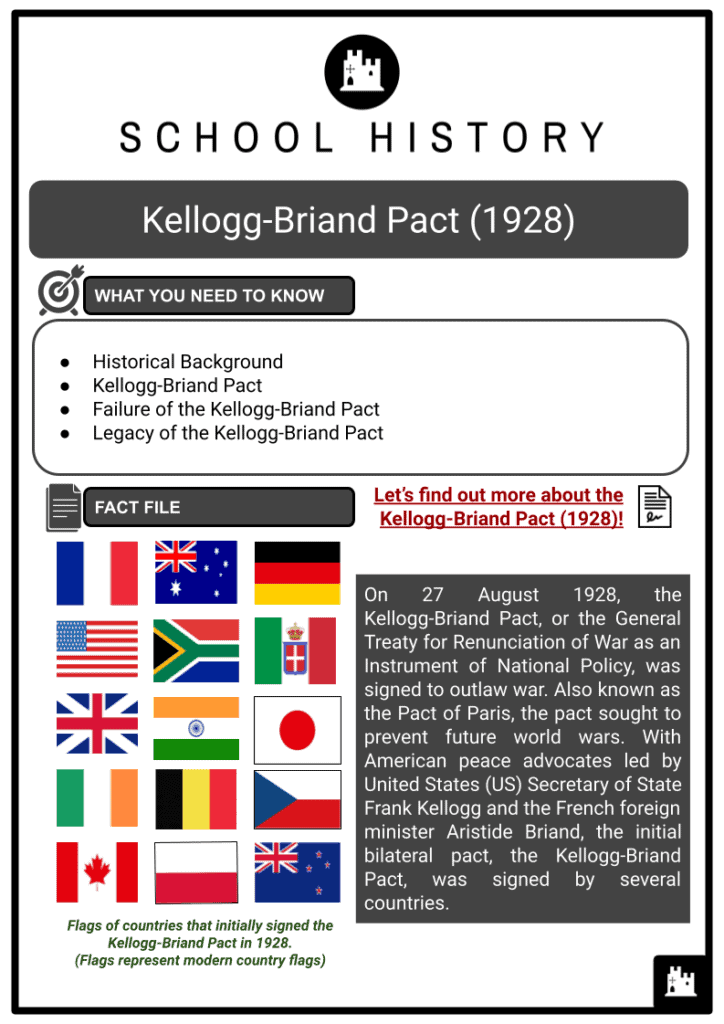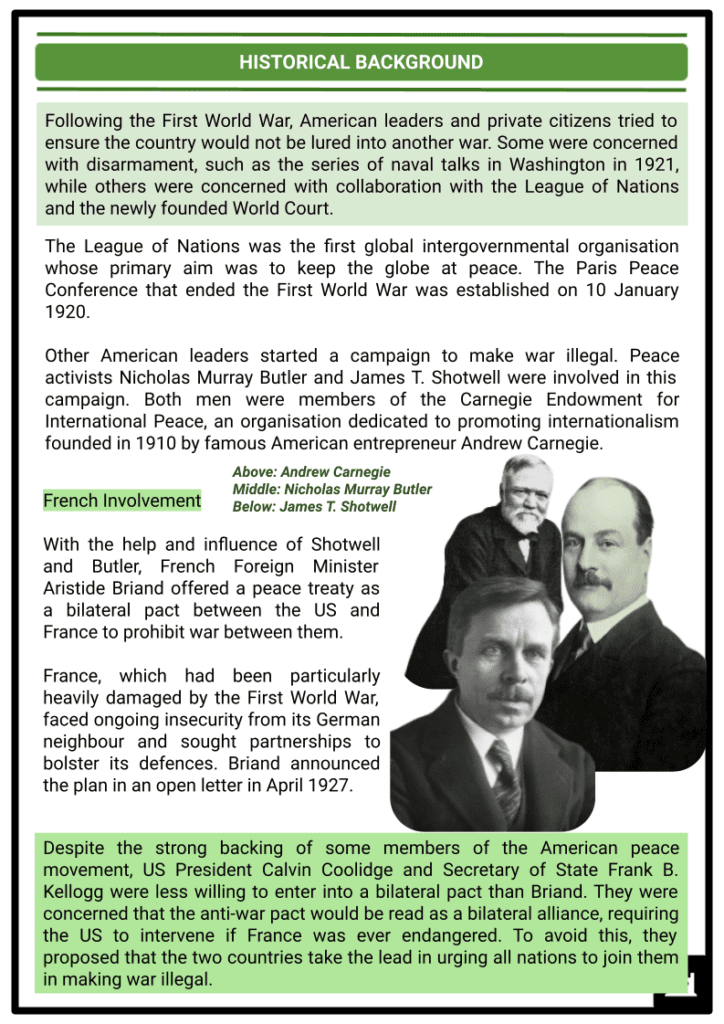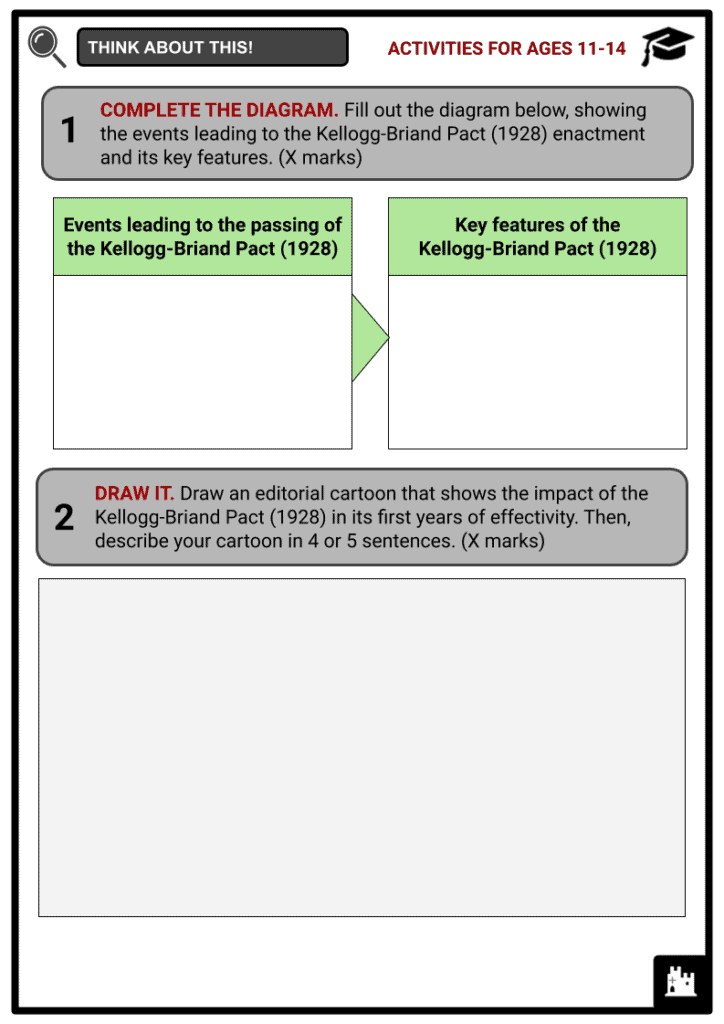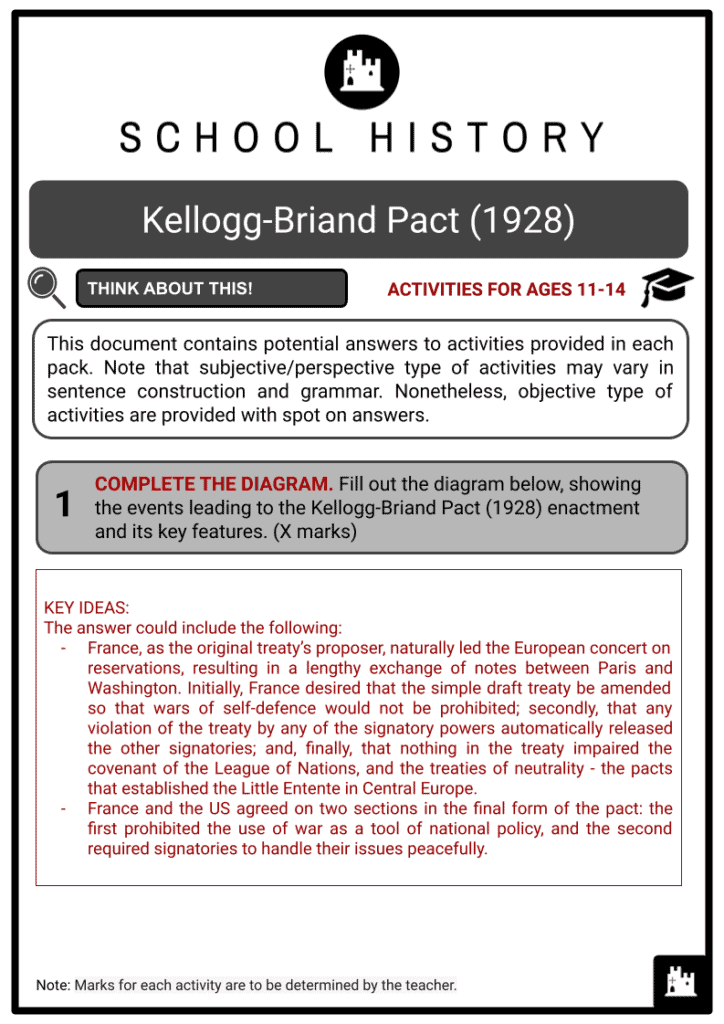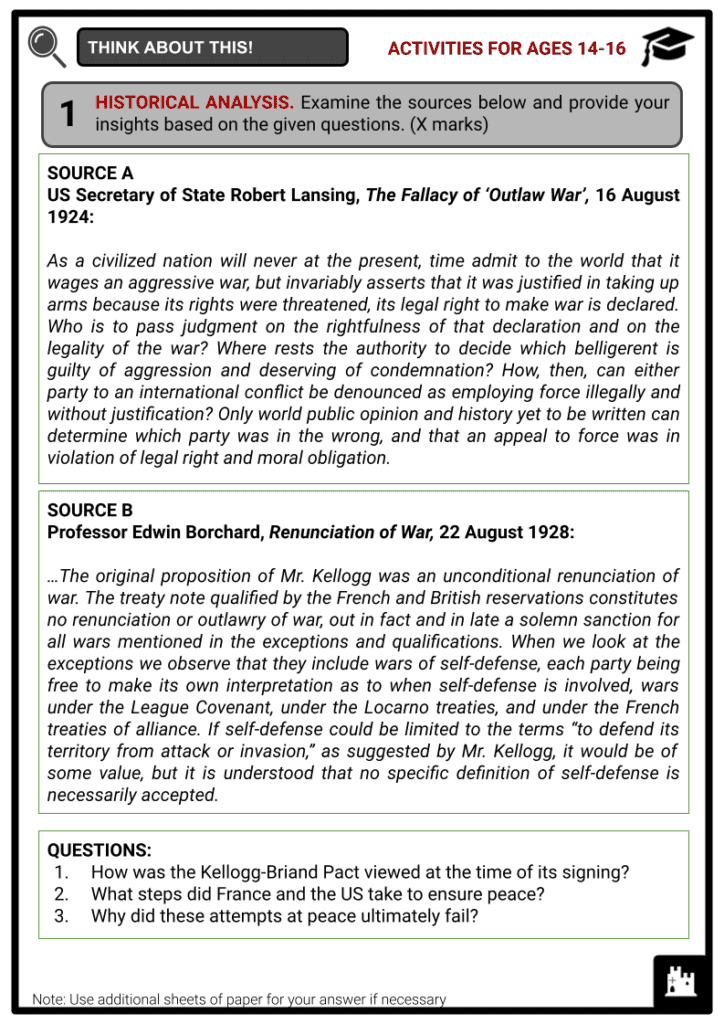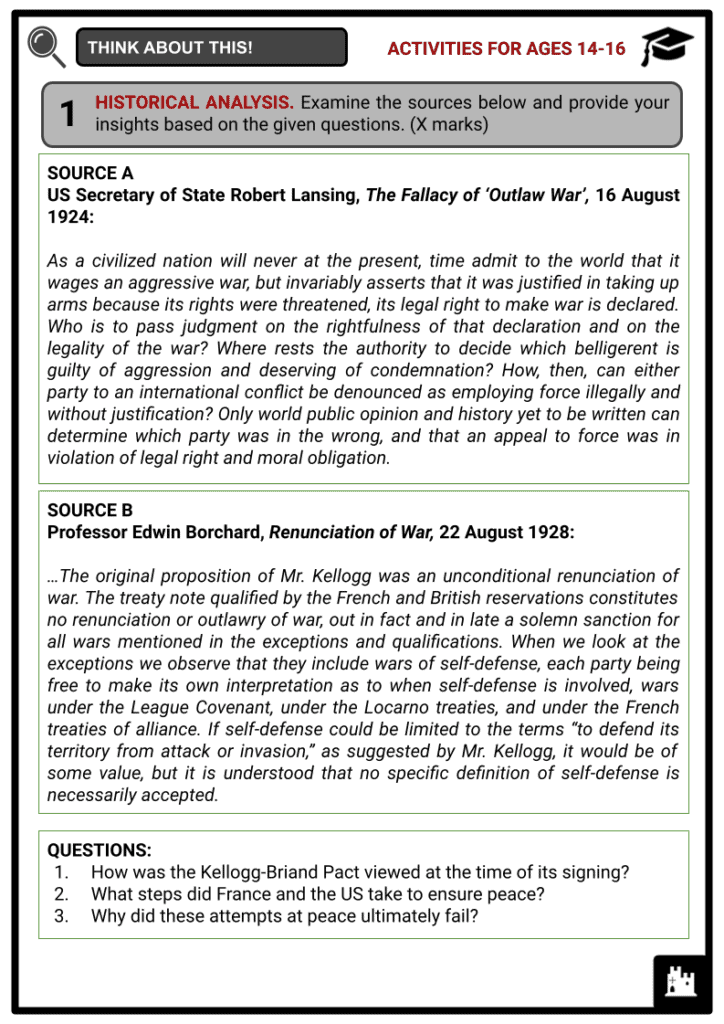Kellogg-Briand Pact Worksheets
Do you want to save dozens of hours in time? Get your evenings and weekends back? Be able to teach about the Kellogg-Briand Pact to your students?
Our worksheet bundle includes a fact file and printable worksheets and student activities. Perfect for both the classroom and homeschooling!
Summary
- Historical Background
- Kellogg-Briand Pact
- Failure of the Kellogg-Briand Pact
- Legacy of the Kellogg-Briand Pact
Key Facts And Information
Let’s find out more about the Kellogg-Briand Pact (1928)!
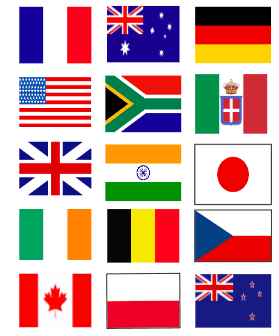
On 27 August 1928, the Kellogg-Briand Pact, or the General Treaty for Renunciation of War as an Instrument of National Policy, was signed to outlaw war. Also known as the Pact of Paris, the pact sought to prevent future world wars. With American peace advocates led by United States (US) Secretary of State Frank Kellogg and the French foreign minister Aristide Briand, the initial bilateral pact, the Kellogg-Briand Pact, was signed by several countries.
HISTORICAL BACKGROUND
- Following the First World War, American leaders and private citizens tried to ensure the country would not be lured into another war. Some were concerned with disarmament, such as the series of naval talks in Washington in 1921, while others were concerned with collaboration with the League of Nations and the newly founded World Court.
- The League of Nations was the first global intergovernmental organisation whose primary aim was to keep the globe at peace. The Paris Peace Conference that ended the First World War was established on 10 January 1920.
- Other American leaders started a campaign to make war illegal. Peace activists Nicholas Murray Butler and James T. Shotwell were involved in this campaign. Both men were members of the Carnegie Endowment for International Peace, an organisation dedicated to promoting internationalism founded in 1910 by famous American entrepreneur Andrew Carnegie.
French Involvement
- With the help and influence of Shotwell and Butler, French Foreign Minister Aristide Briand offered a peace treaty as a bilateral pact between the US and France to prohibit war between them.
- France, which had been particularly heavily damaged by the First World War, faced ongoing insecurity from its German neighbour and sought partnerships to bolster its defences. Briand announced the plan in an open letter in April 1927.
- Despite the strong backing of some members of the American peace movement, US President Calvin Coolidge and Secretary of State Frank B. Kellogg were less willing to enter into a bilateral pact than Briand. They were concerned that the anti-war pact would be read as a bilateral alliance, requiring the US to intervene if France was ever endangered. To avoid this, they proposed that the two countries take the lead in urging all nations to join them in making war illegal.
- The pact’s expansion to include more nations was positively appreciated internationally. Following the devastating losses of the First World War, the idea of declaring war unlawful became extremely popular in international public opinion. Many governments had no problems signing the Treaty because the language clarified that only wars of aggression, not military acts of self-defence, would be protected by it.
- If the pact prevented conflicts, everyone benefited; if it did not, there were no legal ramifications. Negotiations over the pact expanded to include all initial signatories in early 1928. They agreed on two sections in the final form of the pact: the first prohibited the use of war as a tool of national policy, and the second required signatories to handle their issues peacefully.
KELLOGG-BRIAND PACT
- The pact was signed in Paris on 27 August 1928 by fifteen nations. The first countries who signed the pact were France, the US, Australia, Belgium, Canada, Czechoslovakia, Germany, India, Ireland, Italy, Japan, New Zealand, Poland, South Africa, and the United Kingdom, were among the signatories. Later, an additional forty-seven states joined in, resulting in the pact being signed by most of the world’s established nations.

Map showing the signatories of the pact (dark green - Original signatories and light green - Subsequent adherents) - The US Senate ratified the agreement by a vote of 85-1, but only after making reservations to underline that the US involvement did not limit its right to self-defence or force it to act against signatories who violated the pact.
- The Kellogg-Briand Pact was designed to prevent war. In principle, the League of Nations was the international entity that could punish its offenders. However, beyond measures such as international sanctions, the organisation needed more legal powers for real action.
Main text of the Kellogg-Briand Pact
Article I
The High Contracting Parties solemnly declare in the names of their respective peoples that they condemn recourse to war for the solution of international controversies and renounce it as an instrument of national policy in their relations with one another.
Article II
The High Contracting Parties agree that the settlement or solution of all disputes or conflicts of whatever nature or of whatever origin they may be, which may arise among them, shall never be sought except by pacific means.
- The Kellogg-Briand Pact, signed outside the League of Nations in 1928, remained in force. A similar agreement, the General Act for the Pacific Settlement of International Disputes, was signed one month later in Geneva, obligating its signatory states to form conciliation commissions in any dispute.
- The Soviet Union and its Western neighbours, including Romania, agreed to bring the Kellogg-Briand Pact into effect without waiting for other Western signatories to ratify the Litvinov Protocol, signed in Moscow on 9 February 1929.
- The Bessarabian issue had complicated the agreement between Romania and the Soviet Union, and the disagreement between the states over Bessarabia persisted. The primary elements of the pact, which prohibited the use of force in war and promoted peaceful dispute resolution and the use of collective force to deter attack, were included in the United Nations Charter and other treaties.
FAILURE OF THE KELLOGG-BRIAND PACT
- The Mukden Incident, which led to the Japanese invasion of Manchuria a few years later in 1931, was the first major test of the Kellogg-Briand Pact. Even though Japan had signed the pact, the global depression and a limited willingness to go to war to save China prohibited the League of Nations or the US from taking any action to implement it.

Japanese cavalry entering Mukden
Hirohito and Japan
- Japan was an empire in the first half of the twentieth century. By 1910, the Japanese had taken over Korea. The Japanese Empire expanded into China and Southeast Asia from the 1930s to 1945.
- Japan was driven by several issues, including its militarist doctrine and a need for extra resources. Japan’s colonies were referred to as the Greater East Asia Co-Prosperity Sphere by Emperor Hirohito.
- The Mukden Incident started on 18 September 1931, when a lieutenant in the Imperial Japanese Army’s Kwantung Army detonated a small amount of dynamite on a Japanese-owned railway near Mukden.
- Even though the explosion did little or no damage, the Imperial Japanese Army erroneously blamed it on Chinese rebels and used it as a pretext for invading Manchuria. Despite Japan’s signing of the Kellogg-Briand Pact, neither the US nor the League of Nations made any effort to enforce it.
- The Great Depression gripped the US at the time. Other states, experiencing their economic difficulties, were hesitant to commit money to a war to protect China’s independence. After Japan’s military hoax was discovered in 1932, the country plunged into isolationism, culminating in its expulsion from the League of Nations in 1933. The Chinese delegation addressed the League of Nations. After all, Japan violated the Kellogg-Briand Pact, and the country withdrew from the organisation. On 7 July 1937, the Second Sino-Japanese War began and lasted till the end of the Second World War.
Mussolini and Italy
- Despite signing the Kellogg-Briand Pact, Italy invaded Abyssinia (Ethiopia) in 1935, headed by Benito Mussolini. Since 1922, Benito Mussolini has been the country’s fascist leader. The League of Nations attempted to impose penalties on Italy. However, Italy withdrew from the organisation, and penalties were ultimately lifted. Italy also struck a temporary special agreement with France and the United Kingdom. The conflict escalated into the Second Italo-Ethiopian War (1935-1937). It was also one of the pivotal events that demonstrated the League of Nations’ ineffectiveness.

Benito Mussolini
Hitler and Germany
- Due to several factors, Adolf Hitler of the Nazi Party (NSDAP) became Chancellor of Germany in January 1933. They included the party’s populist policies, Germany’s deplorable economic position in the 1920s, and territorial concerns stemming from the Treaty of Versailles.
- Not only did Nazi Germany have supremacist domestic policies that gave ethnic Germans preferential treatment, but it also planned to expand into other sections of Europe.
- This expansion intended to regain territory Germany felt lost due to the First World War settlement, such as French Alsace-Lorraine (Alsace-Moselle) and other lands such as the Soviet Union. The concept of Lebensraum (living space) for Germans in occupied Slavic lands was promoted by Nazi theorists.

Adolf Hitler - Some European countries signed treaties with Germany at this time. The treaties were mostly bilateral non-aggression pacts, such as the Molotov-Ribbentrop Pact signed by Germany and the Soviet Union in 1939, vowing not to attack one other. The Munich Agreement of 1938 between Germany, Britain, France, and Italy granted Germany control of Czechoslovakia’s Sudetenland, followed by Polish and Hungarian annexation of areas of the country. In contrast, the 1940 Tripartite Pact between Germany, Italy, and Japan was an Axis military alliance.
- The Second World War began in 1939 when Germany attacked all of Czechoslovakia and, subsequently, Poland. Hitler also violated the Molotov-Ribbentrop Pact by attacking the Soviet Union in June 1941. As a result, Germany’s actions demonstrated a pattern of evasion of both the Kellogg-Briand Pact and multiple non-aggression treaties.
LEGACY OF THE KELLOGG-BRIAND PACT
- While it was acknowledged at the time, the pact did not prevent the Second World War or any of the subsequent wars. The Kellogg-Briand Pact, which is still in place today, is at the heart of the United Nations Charter and represents the objectives of interwar proponents for long-term world peace. In 1929, Frank Kellogg received the Nobel Peace Prize for his efforts on the pact.
- The modern equivalent of the Kellogg-Briand Pact is the United Nations Treaty on the Prohibition of Nuclear, which 59 countries have ratified, none of which are nuclear weapons states. The pact, ratified on 7 July 2017, includes a comprehensive set of bans on participation in any nuclear weapon activity. These commitments include pledges not to develop, test, manufacture, acquire, hold, stockpile, use, or threaten to use nuclear weapons.
- The Treaty also forbids the placement of nuclear weapons on national territory, as well as the supply of aid to any State engaged in forbidden acts. The Treaty also requires signatory states to provide adequate assistance to individuals affected by nuclear weapon use or testing, as well as to take necessary and appropriate environmental remediation measures in areas under their jurisdiction or control that have become contaminated as a result of activities related to nuclear weapon testing or use.
- The United Nations adopted a final report, known as the Vienna Declaration, in June 2022, stating that nuclear weapons, like biological and chemical weapons, are now officially and thoroughly outlawed by international law. The report offers a 50-task action plan to make progress in areas such as nuclear weapons elimination, supporting victims of nuclear use and testing, and women and disarmament.
Frequently Asked Questions
- What is the Kellogg-Briand Pact?
The Kellogg-Briand Pact, also known as the Pact of Paris, was signed on 27 August 1928. It was named after its architects, U.S. Secretary of State Frank B. Kellogg and French Foreign Minister Aristide Briand.
- What was the main purpose of the Kellogg-Briand Pact?
The main purpose of the Kellogg-Briand Pact was to renounce war as an instrument of national policy. Its primary goal was to prevent the outbreak of future wars and promote peaceful conflict resolution.
- How many countries signed the Kellogg-Briand Pact?
Initially, 15 nations signed the pact in 1928. Over time, the number increased, and by the mid-1930s, more than 60 countries had become signatories.

